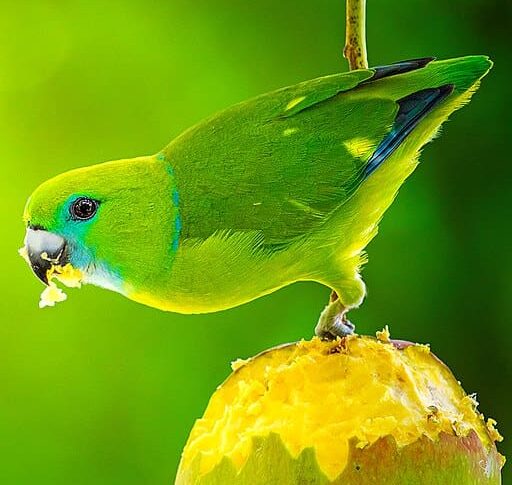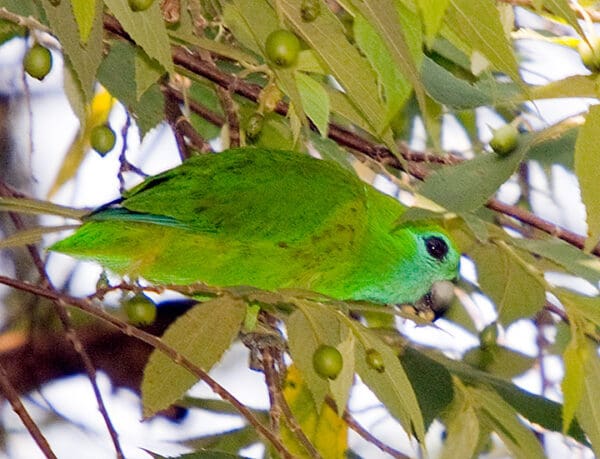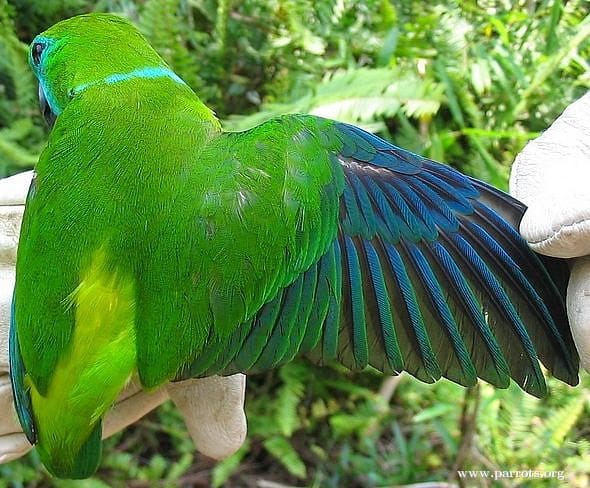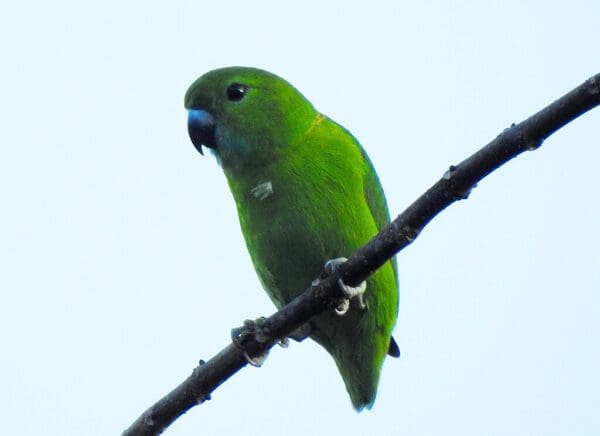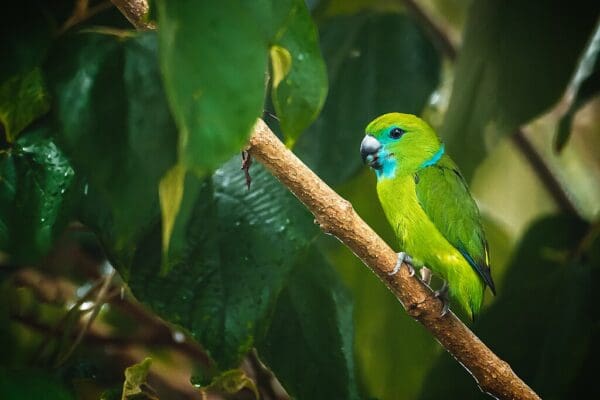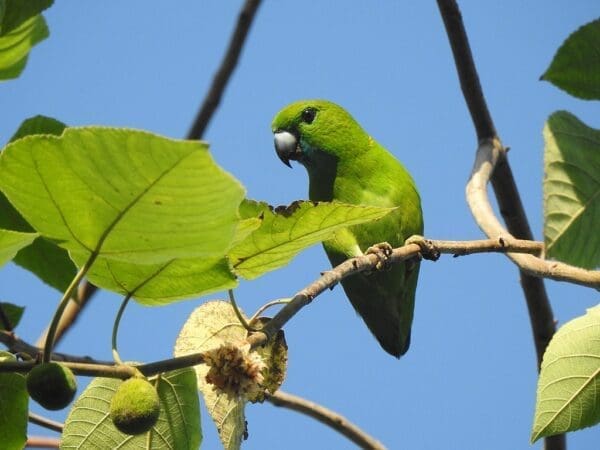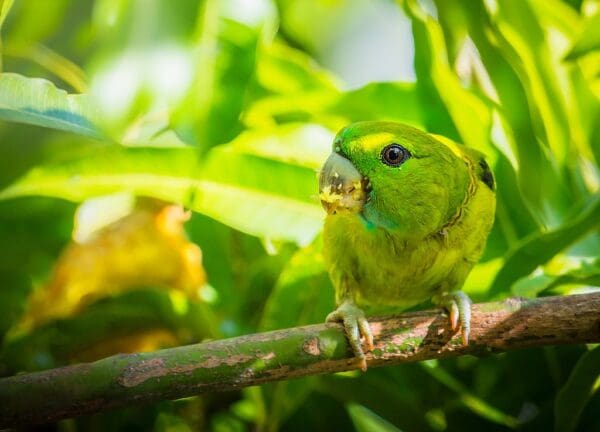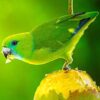
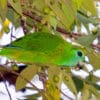
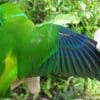
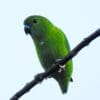

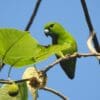
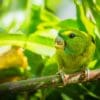
![© Len Worthington [CC BY-SA 2.0] via Flickr A wild Guaiabero perches in a tree](https://parrots.org/wp-content/uploads/2023/01/wpt_Guaiabero_1275-3-100x100.jpg)
DID YOU KNOW?
The Guaiabero’s common name is derived from its fondness for guavas.

Bolbopsittacus

lunulatus
Size:
15 cm (5.8 in)
Weight:
65-70 g
Subspecies including nominate:
four: B.l. lunulatus, B.l. intermedius, B.l. callainipictus, B.l. mindanensis
Colour Adult:
B.l. lunulatus: Male-in general plumage yellow/green; pale blue face and throat; pale blue collar surrounding hindneck; green/yellow rump and upper tail coverts. Beak silver/grey tipped with black. Eye dark brown. Female-blue throat and lower cheeks; yellow collar surrounding hindneck, the feathers lightly scalloped with black; yellow/green rump, with lightly black scalloped feathers.
B.l. intermedius: Male-dark blue face tinted with purple; bright blue collar. Female-blue confined to throat; cheeks pale green; paler green around eyes; faint orange/yellow collar.
B.l. callainipictus: Male-as in intermedius, but in general plumage more yellow, especially on underparts; face and nuchal collar dark and green/blue; cheeks less blue. Female-as in intermedius, but in general plumage more yellow; rump and nuchal collar more yellow and brighter.
B.l. mindanensis: Male-green cheeks parting blue around eyes from blue of throat; darker and brighter blue collar than in lunulatus; yellow tint to green head. Female-as in lunulatus, but head green tinted yellow.
Colour Juvenile:
B.l. lunulatus: As in adult female, but beak pale grey with yellow at base of lower mandible.
B.l. intermedius: As in adult female.
B.l. callainipictus: As in adult female.
B.l. mindanensis: As in adult female.
Call:
Calls made in flight are high-pitched and abrupt. Emits softer sounds while feeding.
More Information:
Content Sources:
CITES
BirdLife International
Cornell Lab of Ornithology/Birds of the World
Parrots: A Guide to Parrots of the World, Juniper and Parr, 1998
Parrots of the World, Forshaw, 2006. 2010 edition
Lexicon of Parrots, Thomas Arndt.
Captive Status:
Rare to uncommon.
Longevity:
—
Housing:
Flight enclosure 1 x 1.5 x 1.2 m (3.3 x 5 x 4 ft) during acclimatisation period, later in flight 3 x 1 x 2 m (9.8 x 3.3 x 6.5 ft).
Diet:
Fruits such as: guava, mango, peaches, pears and apples; vegetables such as: carrots, zucchini, sweet bell peppers; cooked beans and pulses combined with a complete pellet; small amounts of sprouted seed such as: sunflower, millet, buckwheat, canary seed; lory mix comprised of: fruit, pollen, brewer’s yeast, rice flakes, multigrain flakes, dextrose; regular vitamin and mineral supplements.
Enrichment:
Moderate chewer, so provide fresh non-toxic, unsprayed flowering, fir, pine or willow branches, wooden block toys and vegetable tanned leather toys.
Nest Box Size:
—
Clutch Size:
3-4
Fledging Age:
90-110 days
Hatch Weight:
—
Peak Weight:
—
Weaning Weight:
—
World Population:
Unknown but described as fairly common. Decreasing.
IUCN Red List Status:
Least Concern
CITES Listing:
Appendix II
Threat Summary:
Reported as fairly common in a moderately limited range. This species is considered to have a medium dependency on forest habitat and tree cover is estimated to have declined by 5.5% within its range over the past 10 years. It is tentatively suspected that this may have led to a 1-19% decline in the species’ population over the same period.
Range:
B.l. lunulatus: Restricted to Luzon, N Philippines.
B.l. intermedius: Leyte and Panaon, C Philippines.
B.l. callainipictus: Samar, C Philippines.
B.l. mindanensis: Restricted to Mindanao, S Philippines.
Habitat:
Found up to 600 m (1968 ft) in open woodland, forest, forest edge, secondary growth, savanna, farmland, orchards and mangroves.
Wild Diet:
Feeds on fig seed and fruits, particularly guavas, and berries.
Ecology and Behaviour:
Seen singly, in pairs or small flocks of up to 20 birds. Inconspicuous while foraging and resting in canopy; easily seen while flying.
Clutch and Egg Size:
3-4 eggs (captive)
Breeding Season:
Breeding condition by March.
Related Links:
—
